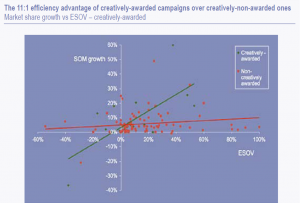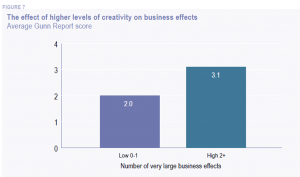The debate about creativity and business impact is not a new one. However, despite growing evidence that creatively awarded campaigns do a better job at building a brand’s business, many agencies still find it very hard to sell creative work and convince clients that persuasion and/or recall are not the most important metrics when deciding what the best ideas are.
I won’t go through the long list of papers that build a case for creativity, since this would blow off this post. Instead I’ll share some recent findings from the IPA (Institute of Practitioners in Advertising) and Millward Brown, which demonstrate with hard facts why agencies and clients alike should be pushing for more creative work.
Last year the IPA in collaboration with thinkbox published a paper called Creativity and Effectiveness report. The paper is really worth a read and here are the most strinking findings:
1. Creatively awarded campaigns are more effective at growing share than non-awarded campaigns:
The graph below clearly demonstrates the efficiency advantage of creatively awarded campaigns. On average creatively awarded campaigns generate 5,7% of market share growth for every 10 points of ESOV (ESOV stands for Excess Share of Voice and is defined as Share of Voice minus Share of Market). This is 11 times more than non-awarded campaigns:
The “confidence effect” is the second key advantage of creatively awarded campaigns. The study showed that awarded campaigns deliver a “confidence” level of 99,9% on the business impact vs. 87% for non-awarded campaigns. Being able to predict the positive impact of a campaign with a significant higher degree of confidence is another essential argument for CMOs facing times of high uncertainty and increased ROI pressure.
2. The more “creative” a creative campaign gets, the better it is for the business:
The IPA paper also tested the following hypothesis “if creative campaigns drive market share then greater creativity should drive share even more”. Indeed the comparison between the campaigns that scored highest in the Gunn Report (the Gunn Report is a global index a creative excellence in advertising) and those which scored lowest showed that the highest scoring campaigns also had the biggest business impact:
Dominic Twose and Polly Wyn Jones from Millward Brown recently published a paper about “Creative effectiveness”. Building on the IPA paper mentioned above, Dominic and Polly took a closer look at the winners of IPA (1996 to 2010), Effies (2007 to 2010) and Cannes (2002 to 2011) for which Millward Brown had conducted the Link pretest.
The interesting conclusion is that the most creative and effective campaigns benefit more from their capacity to involve and engage people than from persuading them. It would be obvioulsy wrong to say that because of these findings “persuasion” should not be considered anymore. Indeed Dominic and Polly acknowledge that “persuasive” ads can have substantial sales effect in the short term. However “persuasion” alone is not enough for the campaign to have a long term sales impact. So marketeers who are in for the long run should encourage campaigns that are enjoyable to watch , which people find involving and resonate emotionally. Last but not least, the authors also underline the importance of branding as a driver of effectiveness: “it is all very well for an ad to leave vibrant memories, but do these memories link to your brand uniquely?”. Importantly “branding” should not be understood as showing your logo or pack as of frame 2 and leaving it there until the end of the commercial. Instead “branding” should be about “making the brand the centre of, and the reason for, the creative idea”.
I think the Walkers “Sandwich” campaign that won one of the Cannes Effectiveness Awards (the attached post is in German) is a good example of how “branding” should be understood:


